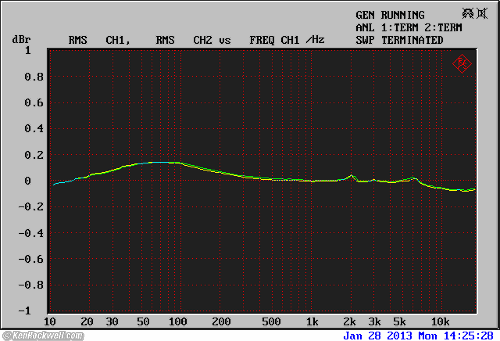jaddie
Account deactivated by request.
- Joined
- Mar 28, 2011
- Posts
- 1,253
- Likes
- 91
Quote:
Thanks for the info.
If you make a statement like "A-Weighting is always 3dB better than unweighted", I'll challenge you every time because the statement is incorrect. The entire point of a weighting curve is to weight audible noise and de-emphasize less audible parts of the spectrum (even if A-weighting is a bad match for reality).
If you state the specific conditions where your statement is true, like flat noise spectrum, then I won't challenge you. You have to know by now that the bulk of the folks reading these forums are fairly fresh to audio, and would read a statement like that and take it to be true in all cases. Such is how myth is born.
Where can I find Cirrus ADC data? I've checked the Cirrus site, they must be under some sort of non-disclosure agreement, the data they publish is sketchy, and doesn't even include the chip used in the iPod.
You aren't measuring your ability to hear real THD though, you are measuring the audibility of a pure tone with various other harmonically related tones added, in essence, your'e confirming the masking curve. Real THD does look that way on spectral analysis with a pure tone test signal but the true audibility of the distortion mechanism should be evaluated with program material. Various distortion mechanisms generate different harmonic distributions and levels, and the specific rate of distortion onset at different signal levels changes how audible distortion becomes very significantly. An extreme example would be distortion when a system is driven into hard clipping vs the softer nonlinearity of a class A amplifier that is over-driven.
Yeah, I don't need to try that and report back. Been there, done that decades ago, when the test signals were analog sine generators and the analyzer was a Tek AA501, and a 5L4N spectrum analyzer. I found very poor correlation between an artificially generated harmonic spectrum and the actual audibility of a distortion mechanism with program material. I don't think years would change that. A device with a certain amount of even-order harmonic distortion produces far less audible distortion than a device with the same amount of odd-order harmonic distortion. Again, under program conditions only, even though an artificially generated harmonic spectrum like that may be audibly similar.
Take a look at TI or Cirrus ADC data and you'll see A Weighting is always 3 dB better than unweighted. Yes, if your noise floor is hugely distorted that rule won't hold. If your signal of interest isn't 1 KHz that rule won't hold. But for flat noise with a 1 KHz test tone, it's 3 dB.
See the section "Noise Floor" on the page below. The noise floor of an MP3 is substantially higher than a 24-bit file format. If this graph is true, then it'll readily be audible.
http://www.quantasylum.com/content/Home/tabid/40/EntryId/23/Apple-iPod-Nano.aspx
For measuring which THD figures I can hear, it's pretty simple to just generate a 1 KHz tone, and then add in a 2, 3, 4, 5, KHz tone at an increased volume and note at which point you can hear the added tone. Try it and report back. It's really hard to hear 2nd and 3rd order distortion, and much much easier to hear 7th order.
Thanks for the info.
If you make a statement like "A-Weighting is always 3dB better than unweighted", I'll challenge you every time because the statement is incorrect. The entire point of a weighting curve is to weight audible noise and de-emphasize less audible parts of the spectrum (even if A-weighting is a bad match for reality).
If you state the specific conditions where your statement is true, like flat noise spectrum, then I won't challenge you. You have to know by now that the bulk of the folks reading these forums are fairly fresh to audio, and would read a statement like that and take it to be true in all cases. Such is how myth is born.
Where can I find Cirrus ADC data? I've checked the Cirrus site, they must be under some sort of non-disclosure agreement, the data they publish is sketchy, and doesn't even include the chip used in the iPod.
You aren't measuring your ability to hear real THD though, you are measuring the audibility of a pure tone with various other harmonically related tones added, in essence, your'e confirming the masking curve. Real THD does look that way on spectral analysis with a pure tone test signal but the true audibility of the distortion mechanism should be evaluated with program material. Various distortion mechanisms generate different harmonic distributions and levels, and the specific rate of distortion onset at different signal levels changes how audible distortion becomes very significantly. An extreme example would be distortion when a system is driven into hard clipping vs the softer nonlinearity of a class A amplifier that is over-driven.
Yeah, I don't need to try that and report back. Been there, done that decades ago, when the test signals were analog sine generators and the analyzer was a Tek AA501, and a 5L4N spectrum analyzer. I found very poor correlation between an artificially generated harmonic spectrum and the actual audibility of a distortion mechanism with program material. I don't think years would change that. A device with a certain amount of even-order harmonic distortion produces far less audible distortion than a device with the same amount of odd-order harmonic distortion. Again, under program conditions only, even though an artificially generated harmonic spectrum like that may be audibly similar.







